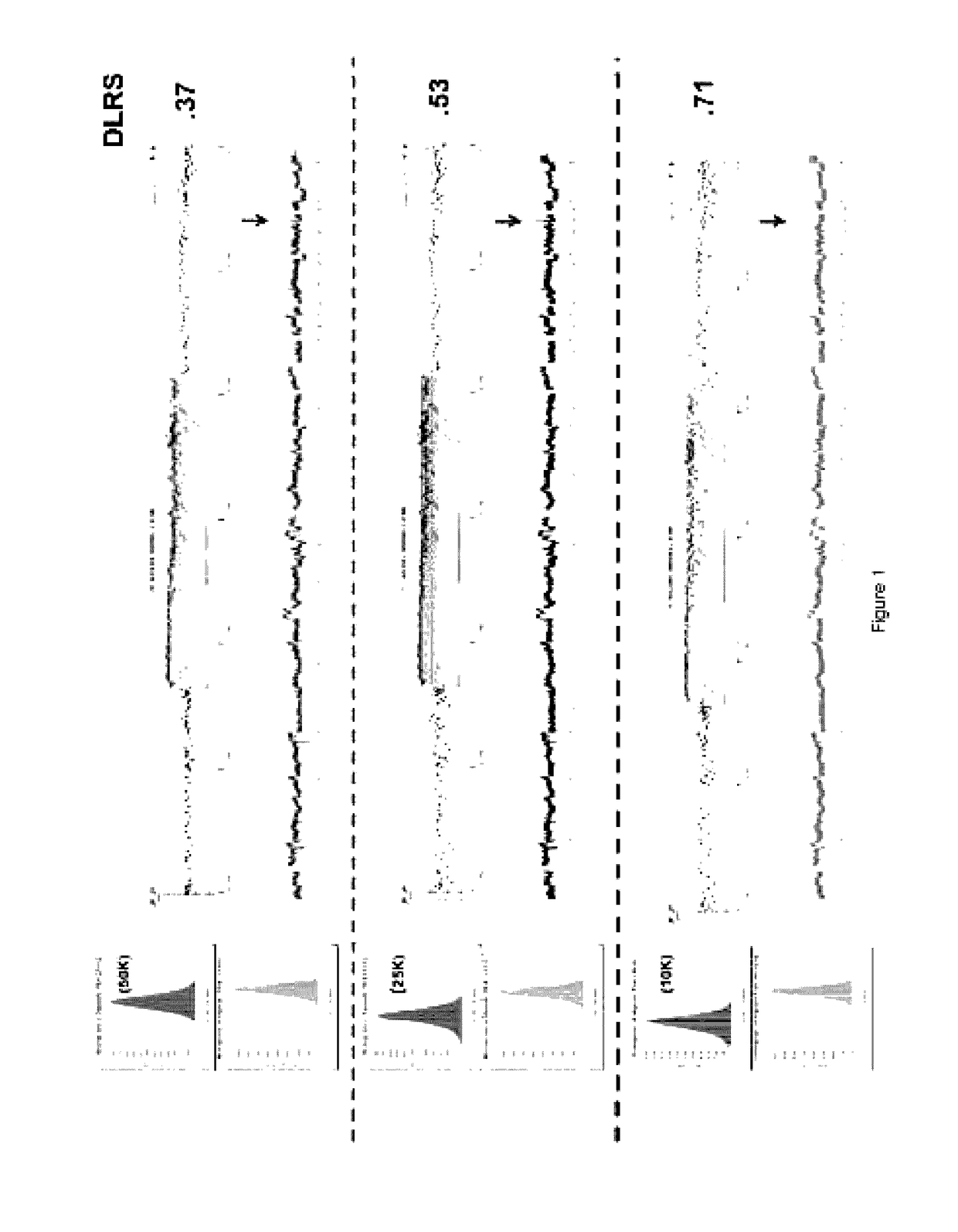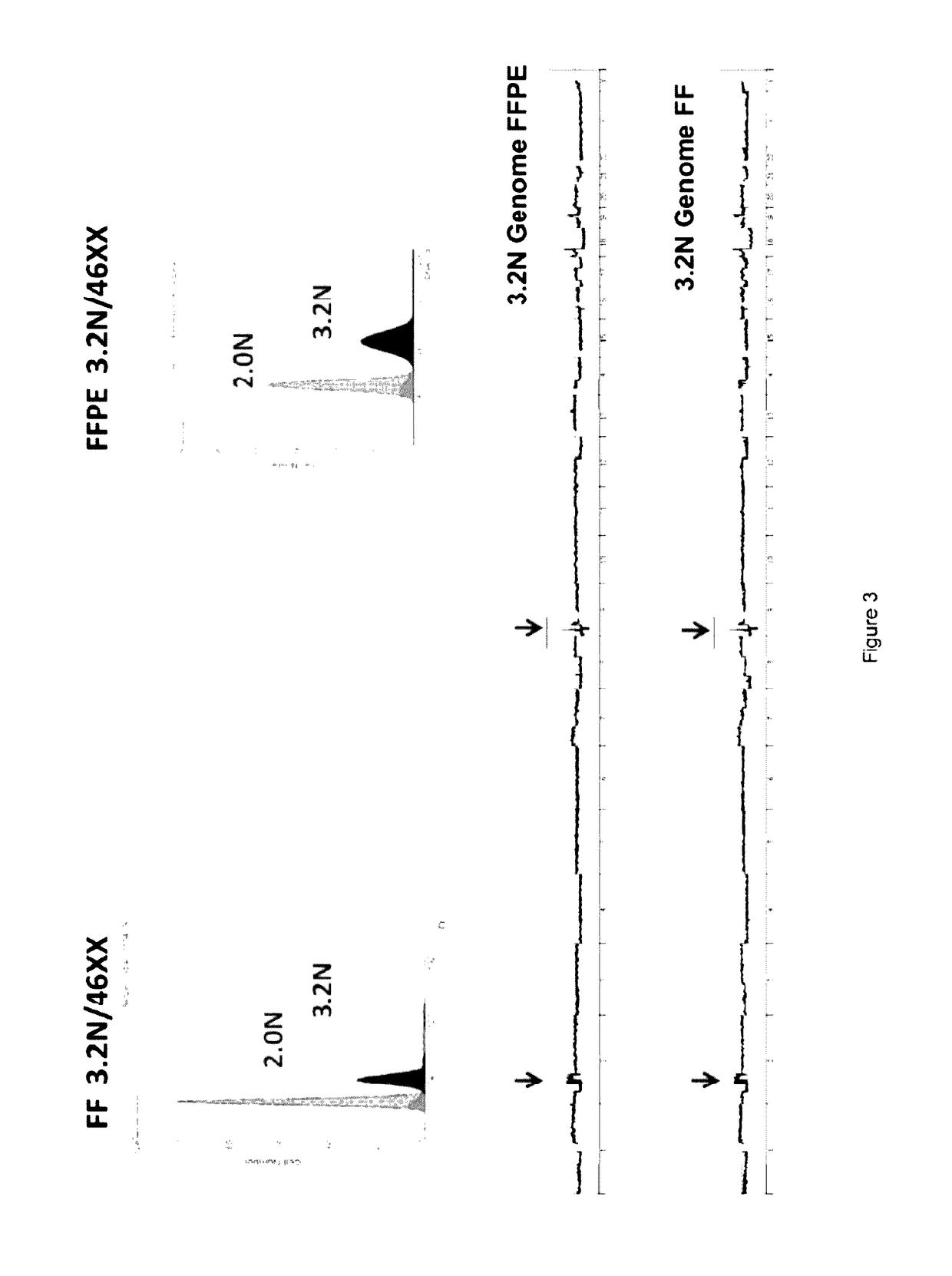System and method of genomic profiling
a genomic and profiling technology, applied in the field of genomic profiling system and method, can solve the problems of difficult to isolate a sufficient number of neoplastic cells for high-definition analysis of cancer genomes, low fragment size of dna template, and high cost of extraction. achieve the effect of improving the resolution of genomic changes
- Summary
- Abstract
- Description
- Claims
- Application Information
AI Technical Summary
Benefits of technology
Problems solved by technology
Method used
Image
Examples
example 1
[0093]Previous studies have shown that DNA content based flow assays enable the discrimination of populations based on ploidy including, for example, diploid, aneuploid, polyploid and elevated 4N(G2 / M) fractions from fresh frozen biopsies of interest. These assays typically have coefficients of variation (c.v.) of + / −0.2N in the histograms for each population identified and can be combined with tissue and or tumor specific markers to sort subpopulations of diploid and aneuploid populations from routinely collected samples of interest. These sorted populations provided optimal templates for the high resolution detection of somatic aberrations in each cancer genome.
[0094]For example, homozygous deletions were meaningfully detected in aCGH experiments using objective thresholds (e.g., log2 ratios 90%) of non-tumor cells. FFPE material samples were initially de-waxed, rehydrated in sequential ethanol washes, treated with EDTA and then processed with a cocktail of enzymes, for example, c...
example 2
Next Generation Sequencing (NGS)
[0101]According to embodiments, next generation sequencing, including parallel sequencing, is used to ascertain the exome and / or genome sequences. The following is provided as an example implementation where next generation sequencing is used.
[0102]Current methods of NGS typically require larger amounts of DNA template as input. Furthermore widely used methods are dependent on genomic DNA templates of highly uniform quality as inputs for efficient library construction. For fresh frozen samples, the use of phi29 can generate high molecular weight template for aCGH experiments. This linear amplification method is dependent on intact templates, such as, samples from high quality fresh frozen biopsies. However, the small fragment sizes of DNAs typically isolated from routine FFPE samples are not suited for linear amplification with highly processive enzymes such as phi29.
[0103]The use of the single primer isothermal amplification (SPIA) was investigated t...
example 3
Aberration Detection and aCGH of Flow Sorted Populations from Breast Carcinoma, Bladder Carcinoma, Glioblastoma, and Ovarian Carcinoma
[0107]To assess the universal utility of the FFPE assays with different tissues samples, TNBC, bladder carcinoma, glioblastoma, and small cell carcinoma of the ovary (SCCO) were analyzed (FIGS. 19-23) and selected aberrations were verified by (fluorescence in situ hybridization) FISH (FIG. 24). Fluorescence in situ hybridizations (FISH) were performed as previously described by Ruiz, et al. (2011) Proc Natl Acad Sci USA 108:12054. Hybridization and post-hybridization washes were done according to the ‘LSI procedure’ (Vysis, Abbott Park, Ill.). Hybridizations with the 9p21 (ZytoLight SPEC p16 / CEN9 Dual probe, Zytovision) and the Cyclin D1 (ZytoLight SPEC CCND1 / CEN11 Dual probe, Zytovision) FISH probes were performed overnight in a humidified chamber at 37° C. All FISH analyses were independently evaluated by two people. Images were obtained by use of a...
PUM
| Property | Measurement | Unit |
|---|---|---|
| volume | aaaaa | aaaaa |
| size | aaaaa | aaaaa |
| pH | aaaaa | aaaaa |
Abstract
Description
Claims
Application Information
 Login to View More
Login to View More - R&D
- Intellectual Property
- Life Sciences
- Materials
- Tech Scout
- Unparalleled Data Quality
- Higher Quality Content
- 60% Fewer Hallucinations
Browse by: Latest US Patents, China's latest patents, Technical Efficacy Thesaurus, Application Domain, Technology Topic, Popular Technical Reports.
© 2025 PatSnap. All rights reserved.Legal|Privacy policy|Modern Slavery Act Transparency Statement|Sitemap|About US| Contact US: help@patsnap.com



